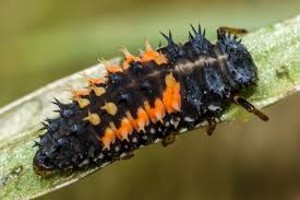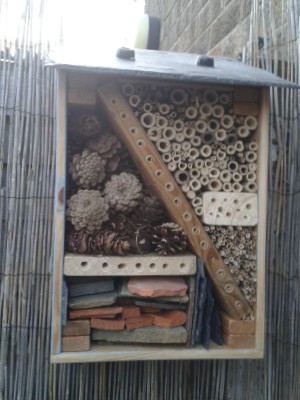Beneficial insects, and how they contribute to the health of your garden
It’s a term that is bandied about a lot, but what exactly do these ‘beneficial insects’ do for you?
Apart from the massive job of pollination, without which we would not be able to survive, there are many benefits to keeping these little critters safe and happy.
Pest control
Hoverflies
Hoverflies, which can look a bit like a wasp (but only a bit) have striped abdomens but not the tiny ‘waspy’ waist or bulging abdomen of the wasp. (Please note that wasps are enormously beneficial as pollinators and some even make honey!) They feed on nectar and pollen, thus pollinating our flowers while going about their business. Their offspring, however, are the real bonus as they voraciously devour aphids and other sap suckers which spread viruses, give rise to sooty mould and seriously damage the new sappy tip growth of many plants.
To attract them, grow plants like Alyssum, Achillea, Dill, Cosmos, Althea and other members of the mallow family, Lemon Balm, Potentilla and Calendula.
To protect them, make piles of leaf litter and decomposing logs or tree bark and compost heaps.
Ladybirds
Despite the name these shiny lovelies are confirmed carnivores who prey on all the little bugs we really don’t want, such as aphids and two spotted mites, (red spider mite). The parents will get around all over the garden munching on nasties as they go but will also lay eggs in the middle of large infestations. These emerge as comparatively long black larvae with serrated edges on their abdomens and will munch their way through up to 80 aphids per day each, thus wiping out the infestation in short order. Their blood thirsty appetite is matched by their appearance and they are a welcome sight for all gardeners. Rosy calls them little crocodiles.

To attract them, avoid spraying chemicals and plant fast growing perennials and wildflowers.
To protect them, build bug hotels (not all bug hotels are equal) and leave piles of leaves or logs in sheltered areas. Many are solitary hibernators and others hibernate in colonies. Sometimes they will come indoors to get protection and disperse as soon as the weather warms in spring. Particularly welcome in green houses, they love to eat red spider mite which could destroy crops grown under glass like tomatoes, cucumbers, melons and grape vines.

Parasitic wasps
These teeny tiny little hunters do not sting and you’re unlikely to notice them unless you are looking very closely. But, you may see the remains of their victims, the hollowed-out bodies of pests. They lay their eggs on or in the host pest. The eggs then hatch and eat the host before emerging as adults to start the process all over again. Fantastic for controlling caterpillars, that love to eat your brassicas as well as sawflies, aphids and ants.
To attract them, plant as for Hoverflies.
To protect them, try not to tidy the garden too much in Winter. Cutting down grass and plant stems, removing piles of leaves or logs can destroy over wintering sites for many beneficial insects.
Lacewing
Easy to spot, these pretty fliers have transparent wings that are twice the length of their abdomen. They are also confirmed carnivores who like nothing more than lunching on aphids and insect eggs.
Both the parents and offspring have big appetites and the larvae have pincer like mouthparts that hold their pray while they suck out the insides of their victim.
To attract them, plant open flowered annuals, perennials and wild flowers.
To protect them, leave piles of logs or rotting wood in sheltered sites, plant dense hedges and don’t evict them if they hibernate inside your home or outbuildings.
Ground beetles
Probably my favourite hunter in the garden because these little darlings love to feast on slugs and snails.
It’s a bit gross but they vomit on their prey and let the liquid start to decompose the unfortunate mollusc before they tuck in. As the name suggests many of these can’t fly so you’ll find them scurrying about patrolling their surroundings looking for their next meal. Many are nocturnal and like to hide under stones, logs and leaf litter during the day, so again don’t be too quick to tidy up. Most like shady sites.
When threatened they can release a spray of noxious fluid but it can’t hurt us. The females can also use this to deter over amorous males.
To attract them, leave plenty of areas of cover in the shadier sites in your garden.
To protect them, ditto.
Hedgehogs and Birds
It goes without saying that if you have plenty of suitable plants, you’ll get pollinators and these will attract birds. But even seed eating birds can be super useful in maintaining the balance in your garden because they too will happily snack on aphids. Larger birds like Blackbirds and Robins will often take a mollusc or three if available and Hedgehogs will certainly make a dent in the population.
In return we can make our gardens more-friendly by planting plenty of open flowered plants as well and fruit and berry bearing plants for Autumn and Winter. Leave the chemicals out of the equation as no matter what you use you’ll be knocking some beneficial beastie out of the loop and upsetting the balance of nature, which will ultimately lead to more pests getting a free hand to multiply. Also, by adding pesticides, herbicides and fungicides to the environment you will inevitably find these compounds building up in the creatures at the top of the food chain. Finally get together with your neighbours to install some openings in your boundaries to allow roaming hedgehogs to come visit.
Pollination
As mentioned previously many of the predatory insects also serve a double purpose by pollinating as they move around the garden. It is also somewhat contradictory that many of the pests undertake this function too. Which is why controlling numbers is always preferable to eradicating a particular species.
Caterpillars may decimate some of your veggies and turn some of the foliage of your prize plants into lacy doilies, but if enough are able to make it through to maturity they become the butterflies and moths that are beautiful as well as useful pollinators. Each has their own speciality and many are under threat because of loss of their natural habitats and by our harmful and indiscriminate use of chemicals.
By allowing nature to sort out the balance you will allow these populations to recover as well as providing some extra nourishment for your bird population. Its all connected in a loop and it is it not our job to mess with that.
A friend of mine loved to grow brassicas but was acutely aware of this need for nature to balance herself. So, at the end of each row of veg was a sacrificial plant that was there purely for the benefit of garden beasties. He also raised pollen and nectar rich flowers between the rows to bring in more pollinators and provide cut flowers for the house. Caterpillars, slugs and snails were carefully moved from the veg he planned to keep and placed on the sacrificial plants. He had a great crop that year and the beneficial predators kept the rest of the area in balance. Not all the leaves were perfect by any means but the crop that remained was more than enough to feed him and his wife. He has continued this practice every year since.
It is also important to note that not all slugs are out to eat your best plants. Many of the larger slugs do not eat green material at all, but feast on dead plant matter, thus acting as little composters. The Leopard slug is also a hunter and will eat smaller slugs. Along with worms and other micro beasties, this constant recycling of plant material helps to improve our soil by aerating and refining the texture of the topsoil and organic layer, as well as providing some nutrients.
This very wet year has seen a huge rise in numbers of the molluscs that are living in our gardens but the birds and other ‘slime diners’ have had a feast. Next year there will likely be more predators to feast on the population and when numbers drop, the predator numbers will drop accordingly. Most animals only breed if there is enough food to feed their offspring. Balance is a wonderful thing.
